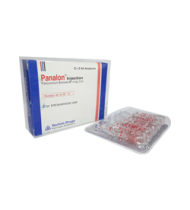Pancuronium Bromide
Indications
Pancuronium is indicated as an adjunct to general anesthesia, to facilitate endotracheal intubation and to provide skeletal muscle relaxation during surgical procedure of medium and long duration.
Pharmacology
Pancuronium is a typical non-depolarising curare-mimetic muscle relaxant. It acts as a competitive acetylcholine antagonist on neuromuscular junctions, displacing acetylcholine (hence competitive) from its post-synaptic nicotinic acetylcholine receptors. It is, unlike suxamethonium, a non-depolarising agent, which means, that it causes no spontaneous depolarisations upon association with the nicotinic receptor in neuromuscular junction, thus producing no muscle fasciculations upon administration. Pancuronium has no hormonal activity. It exerts slight vagolytic activity (i.e. diminishing activity of the vagus nerve) and no ganglioplegic (i.e., blocking ganglions) activity.
Nondepolarizing neuromuscular blocking agents inhibit neuromuscular transmission by competing with acetylcholine for the cholinergic receptors of the motor end plate, thereby reducing the response of the end plate to acetylcholine. This type of neuromuscular block is usually antagonized by anticholinesterase agents.
Nondepolarizing neuromuscular blocking agents inhibit neuromuscular transmission by competing with acetylcholine for the cholinergic receptors of the motor end plate, thereby reducing the response of the end plate to acetylcholine. This type of neuromuscular block is usually antagonized by anticholinesterase agents.
Dosage & Administration
Intravenous:
Facilitate endotracheal intubation, Muscle relaxant in general anaesthesia:- Adult: Initially, 50-100 mcg/kg by inj, may reduce to 20-60 mcg/kg if given after suxamethonium. Maintenance: 10-20 mcg/kg.
- Child: 0-30 days Initially, 30-40 mcg/kg. Maintenance: 10-20 mcg/kg; >1 mth Same as adult dose.
- Adult: 60 mcg/kg every 1-1.5 hr or less frequently.
Interaction
Increased effect with inhalational anaesth, other non-depolarising muscle relaxants, antibiotics (polypeptide and aminoglycoside group), diazepam, propranolol, thiamine (high dose), MAOIs, quinidine, Mg sulfate, protamine, nitroglycerin, narcotic analgesics, diuretics, phenytoin, α and β adrenergic blockers, imidazoles, norepinephrine and epinephrine and prior suxamethonium. Decreased effect with neostigmine, edrophonium, corticosteroids (high dose); KCl, Ca chloride and NaCl; heparin (temporary decrease), azathioprine, theophylline, pyridostigmine, neurolept analgesia and propanidid.
Contraindications
Pancuronium must not be administered to patients with know hypersensitivity to puncuronium of the bromide ion.
Side Effects
Tachycardia, HTN, bradycardia, bronchospasm, hypotension, CV collapse, excessive salivation; pain or local skin reactions at inj site. Rarely, hypersensitivity reactions.
Pregnancy & Lactation
Category C: Either studies in animals have revealed adverse effects on the foetus (teratogenic or embryocidal or other) and there are no controlled studies in women or studies in women and animals are not available. Drugs should be given only if the potential benefit justifies the potential risk to the foetus.
Precautions & Warnings
Patient with burn injury, biliary tract disease, pulmonary disease, muscular dystrophies, myasthenia gravis, myasthenic syndrome, electrolyte disturbance, altered pH, dehydration, CV disease, oedema, raised catecholamine concentration and those at risk of HTN. Renal and hepatic impairment. Childn. Pregnancy and lactation.
Use in Special Populations
Obese patient: Adjust dose based on ideal body wt.
Renal Impairment:
Renal Impairment:
- Haemodialysis/peritoneal dialysis patient: Avoid use.
- Continuous renal replacement therapy: 50% of normal dose.
- CrCl (mL/min) <10: Avoid use.
- CrCl (mL/min) 10-50: 50% of normal dose.
Overdose Effects
Symptoms: Prolonged apnoea, resp depression and/or muscle weakness. Death may follow acute resp failure.
Management: May administer neostigmine 2.5 mg and atropine 1.2 mg to reverse neuromuscular block while ventilation is continued. When admin of the anticholinesterase agent fails to reverse neuromuscular blockade, continue ventilation until spontaneous breathing is restored.
Management: May administer neostigmine 2.5 mg and atropine 1.2 mg to reverse neuromuscular block while ventilation is continued. When admin of the anticholinesterase agent fails to reverse neuromuscular blockade, continue ventilation until spontaneous breathing is restored.
Therapeutic Class
Non depolarizing muscle relaxants
Panalon Injection 4 mg/2 ml
IndicationsPancuronium is indicated as an adjunct to general anesthesia, to facilitate endotrac..
55.00Tk.
Showing 1 to 1 of 1 (1 Pages)

